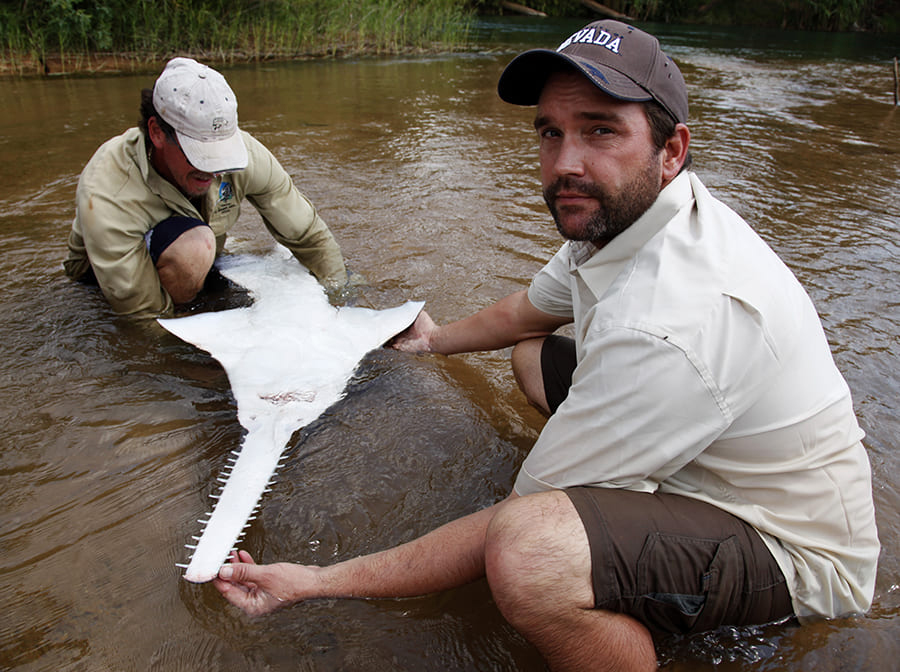Monster-size aquatic invaders are flying out of the water, some fish are eating cats and dogs, while others are taking over rivers and may be causing the extinction of hundreds of native species. And all are part of a series of five new shows on the National Geographic Channel about Megafish hosted by Zeb Hogan, research biologist from the University of Nevada, Reno and a National Geographic Explorer.
The shows offer a mix of science, adventure, and exploration around the world, with challenges such as expeditions up the Amazon and the remote Rio Roosevelt, a rugged 400-mile-long river in western Brazil that may not have been traveled since Theodore Roosevelt attempted it in 1913.
“Four of the shows focus on invasive species issues, where the giant fish are taking over new habitats,” Hogan said. “This series of shows focuses heavily on invasive-species issues, a critically important topic for the health of aquatic ecosystems like Lake Tahoe, the Mississippi River, and the Great Lakes.”
Monster Fish: Flying Carp airs Mon., July 19 and Sat., July 24 at 10 p.m. on the National Geographic Channel. It features flying fish from Asia that are invading America’s waterways. They’ve already infiltrated the Mississippi River system and are close to spreading to the Great Lakes.
“I’m alarmed by what I’ve learned,” Hogan said, “These carp put on several pounds each year, a phenomenal growth rate. They quickly outgrow any predators but humans. Native fish don’t stand a chance against them; they can grow to almost 100 pounds.”
With no natural predators, the flying fish are growing to mega-proportions, jumping 10 feet in the air and injuring boaters, in addition to threatening local ecosystems as they squeeze out native fish. In this episode, Hogan heads to the Illinois River, one of the areas where this fish population is most dense, to see what can be done to stop them.
In the episode that airs Mon., July 19 and Sat. July 31 at 10 p.m., Monster Fish: Alligator Gar, Hogan goes in search of the alligator gar, one of North America’s toothiest and most misunderstood freshwater monster fish. These bizarre-looking creatures reach lengths of 10 feet and 300 pounds, have a long jaw like an alligator with a mouthful of razor-sharp teeth and can breathe air. Over the past several decades they have disappeared from their northern ranges and are currently vanishing from the bayous and marshes of the southern United States.
Today, alligator gars are facing a new threat: the oil spill in the Gulf of Mexico will likely impact the habitat of the gar – and Hogan is determined to find out if this fish will be able to survive in a modern world.
“The overall idea behind the shows remains the same,” Hogan, an associate research professor, said. “It’s a research project to find, study, and protect the world's largest freshwater fish and their habitats.”
The Monster Fish series continues Mon., July 26, at 10 p.m. with “Giants of Thailand,” featuring freshwater goliath fish such as the 600-pound Siamese carp, 10-foot-long Mekong giant catfish – the world's largest freshwater fish – and the endangered giant freshwater stingray, among others.
“Our show in Thailand investigates why Thailand is home to so many record-breaking fish species - both native and invasive,” Hogan said. The show also runs on Aug. 7.
In Monster Fish: Jungle Catfish on Mon., Aug. 2 and Sat., Aug. 14 at 10 p.m., Hogan teams up with kayaking expert Trip Jennings and a team of Brazilian scientists to tackle the remote Rio Roosevelt in western Brazil. It’s believed that this journey is one of the first attempts by outsiders since Theodore Roosevelt’s journey in 1913 to reach the headwaters of the river.
The team navigates Class V rapids in the treacherous river and avoids potentially violent tribesman while working to discover if monster fish are lurking beneath the surface. Within a remarkably diverse ecosystem, the team searches for giant piranhas, painted catfish and may have even found a new species of fish unknown to science.
The team then examines the 400-pound Nile perch in Lake Victoria, which is a textbook example of the dangers of invasives. The Nile Perch invasion is thought to have caused the extinction of hundreds of native species.
The Jungle Catfish episode ends on another South American river, the Madiera, that's famous for its migratory catfish but which will soon be dammed. The dam will sever an important connection between the Amazon headwaters and the sea - and block what's thought to be the longest migration of any species of freshwater fish - almost 4,000 kilometers.
In Monster Fish: Catfish King, Hogan goes to Spain to hunt the Wels catfish, a voracious invasive predator. Legends in Spain claim that the catfish in the Ebro River, which can grow to eight feet long, devours not only cats and dogs and birds, and legends of the fish eating humans come from Germany. The episode premieres Monday, August 9, at 10 p.m. on the National Geographic Channel. In Spain, where the monsters invaded in the 1970s, there are confirmed catches over eight feet long and 200 pounds.
















